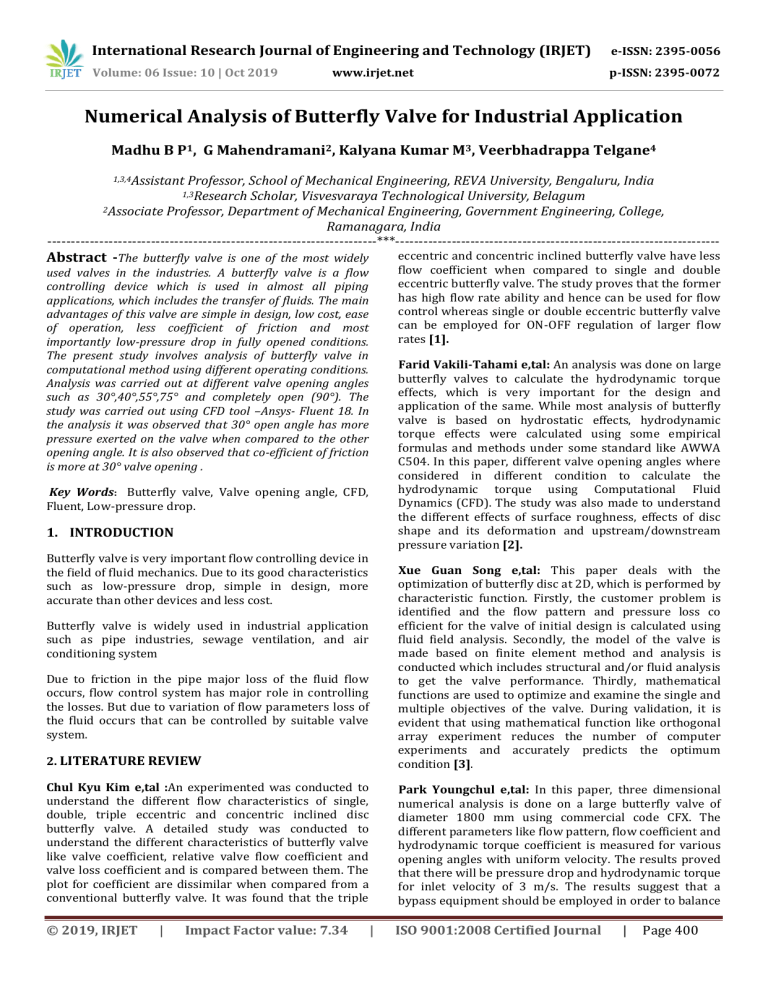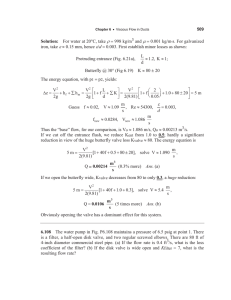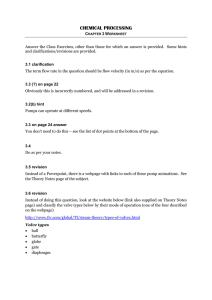IRJET-Numerical Analysis of Butterfly Valve for Industrial Application
advertisement

International Research Journal of Engineering and Technology (IRJET) e-ISSN: 2395-0056 Volume: 06 Issue: 10 | Oct 2019 p-ISSN: 2395-0072 www.irjet.net Numerical Analysis of Butterfly Valve for Industrial Application Madhu B P1, G Mahendramani2, Kalyana Kumar M3, Veerbhadrappa Telgane4 1,3,4Assistant Professor, School of Mechanical Engineering, REVA University, Bengaluru, India Scholar, Visvesvaraya Technological University, Belagum 2Associate Professor, Department of Mechanical Engineering, Government Engineering, College, Ramanagara, India ----------------------------------------------------------------------***--------------------------------------------------------------------1,3Research Abstract -The butterfly valve is one of the most widely eccentric and concentric inclined butterfly valve have less flow coefficient when compared to single and double eccentric butterfly valve. The study proves that the former has high flow rate ability and hence can be used for flow control whereas single or double eccentric butterfly valve can be employed for ON-OFF regulation of larger flow rates [1]. used valves in the industries. A butterfly valve is a flow controlling device which is used in almost all piping applications, which includes the transfer of fluids. The main advantages of this valve are simple in design, low cost, ease of operation, less coefficient of friction and most importantly low-pressure drop in fully opened conditions. The present study involves analysis of butterfly valve in computational method using different operating conditions. Analysis was carried out at different valve opening angles such as 30°,40°,55°,75° and completely open (90°). The study was carried out using CFD tool –Ansys- Fluent 18. In the analysis it was observed that 30° open angle has more pressure exerted on the valve when compared to the other opening angle. It is also observed that co-efficient of friction is more at 30° valve opening . Farid Vakili-Tahami e,tal: An analysis was done on large butterfly valves to calculate the hydrodynamic torque effects, which is very important for the design and application of the same. While most analysis of butterfly valve is based on hydrostatic effects, hydrodynamic torque effects were calculated using some empirical formulas and methods under some standard like AWWA C504. In this paper, different valve opening angles where considered in different condition to calculate the hydrodynamic torque using Computational Fluid Dynamics (CFD). The study was also made to understand the different effects of surface roughness, effects of disc shape and its deformation and upstream/downstream pressure variation [2]. Key Words: Butterfly valve, Valve opening angle, CFD, Fluent, Low-pressure drop. 1. INTRODUCTION Butterfly valve is very important flow controlling device in the field of fluid mechanics. Due to its good characteristics such as low-pressure drop, simple in design, more accurate than other devices and less cost. 2. LITERATURE REVIEW Xue Guan Song e,tal: This paper deals with the optimization of butterfly disc at 2D, which is performed by characteristic function. Firstly, the customer problem is identified and the flow pattern and pressure loss co efficient for the valve of initial design is calculated using fluid field analysis. Secondly, the model of the valve is made based on finite element method and analysis is conducted which includes structural and/or fluid analysis to get the valve performance. Thirdly, mathematical functions are used to optimize and examine the single and multiple objectives of the valve. During validation, it is evident that using mathematical function like orthogonal array experiment reduces the number of computer experiments and accurately predicts the optimum condition [3]. Chul Kyu Kim e,tal :An experimented was conducted to understand the different flow characteristics of single, double, triple eccentric and concentric inclined disc butterfly valve. A detailed study was conducted to understand the different characteristics of butterfly valve like valve coefficient, relative valve flow coefficient and valve loss coefficient and is compared between them. The plot for coefficient are dissimilar when compared from a conventional butterfly valve. It was found that the triple Park Youngchul e,tal: In this paper, three dimensional numerical analysis is done on a large butterfly valve of diameter 1800 mm using commercial code CFX. The different parameters like flow pattern, flow coefficient and hydrodynamic torque coefficient is measured for various opening angles with uniform velocity. The results proved that there will be pressure drop and hydrodynamic torque for inlet velocity of 3 m/s. The results suggest that a bypass equipment should be employed in order to balance Butterfly valve is widely used in industrial application such as pipe industries, sewage ventilation, and air conditioning system Due to friction in the pipe major loss of the fluid flow occurs, flow control system has major role in controlling the losses. But due to variation of flow parameters loss of the fluid occurs that can be controlled by suitable valve system. © 2019, IRJET | Impact Factor value: 7.34 | ISO 9001:2008 Certified Journal | Page 400 International Research Journal of Engineering and Technology (IRJET) e-ISSN: 2395-0056 Volume: 06 Issue: 10 | Oct 2019 p-ISSN: 2395-0072 www.irjet.net the pressure drop on both sides of the disc. As the opening angle decreases, the dynamic torque and turbulence increases. Hence these are not desirable for opening angles less than 20° [4]. The figure 1 shows pressure contour of 30° valve opening angle for 0.5 m/s. from the pressure contour it is evident that the pressure continuously decreases from inlet to exit, at the valve edges the values becomes critical due to change in the valve opening angle. The pressure values changes from 12 Pa to 0.3 Pa, but at the valve area the pressure value changes 8.64 Pa to 4.514 Pa. According to the literature reviewed, many researchers have worked on Flow Through butterfly valve experimentally as well as numerically to understand the effect of geometrical parameters on the process of expansion and also flow structure depends on valve opening angle, so our work has been focused on different valve opening angles, different velocities and different turbulent model. 3. Materials and Methods Extensive study of existing literature on experimental and numerical analysis of expansion through Butterfly valve has been done. Butterfly valve geometry, expansion ratios, flow and boundary conditions have been drawn on the basis of the literature survey. Creation of two-dimensional geometry of the Butterfly valve and meshing is done on Workbench of ANSYS 18®. Simulation of expansion is carried on ANSYS FLUENT 18® software using different levels of grid refinement and turbulent models. Grid independence test was carried out for each of the cases to select appropriate number of elements for the computational domain. Validation of simulated results with that of experimental is done and the numerical approach, which resulted in acceptably proximate predictions, is adopted for further study of the cases taken in this work. Post processing features of ANSYS FLUENT are used to generate static pressure, total pressure and velocity contours and Mach number plots for all cases. Parameters that are essential for detailed analysis of expansion like flow exit velocity, pressure at exit are obtained from post processor generated contours and plots. Fig-2: Velocity contour of 30° valve opening angle for 0.5 m/s. Figure 2 shows that the flow velocity at inlet 0.5 m/s is remaining constant till it approaches the valve, there is some change in the velocity and reach zero at some positions over the valve wall where stagnation regions being formed. Due to the decrease in the flow area between the pipe wall and the valve edges, the velocity increases (red color) and reaches a value of 8.52 e+01 m/s. These high velocities causes vortex (or Vortices), eddies and recirculation flow on the downstream surface of the valve disc. The flow then exhibits some turbulence with circulation till it regains its inlet value of 0.5 m/s. It can be seen that the stagnation regions on the upstream valve surface is near the leading edge. 4. RESULT AND DISCUSION Fig-1: Pressure contour of 30° valve opening angle for 0.5 m/s. © 2019, IRJET | Impact Factor value: 7.34 Fig-3: Presuure contour of 55° valve opening angle for 0.5 m/s. | ISO 9001:2008 Certified Journal | Page 401 International Research Journal of Engineering and Technology (IRJET) e-ISSN: 2395-0056 Volume: 06 Issue: 10 | Oct 2019 p-ISSN: 2395-0072 www.irjet.net Figure 3 Shows Static pressure Contour for Velocity 0.5 m/s with valve opening angle 55°.In this plot pressure varies from 1.18e+03 to 1.5+9e-02. Fig-6: Velocity contour of 75° valve opening angle for 0.5 m/s. Figure 6 shows that the flow velocity at inlet 0.5 m/s is remaining constant till it approaches the valve, there is some change in the velocity and reach zero at some positions over the valve wall where stagnation regions being formed. Due to the decrease in the flow area between the pipe wall and the valve edges, the velocity increases and reaches a value of 3.74 m/s. Fig-4: Velocity contour of 55° valve opening angle for 0.5 m/s. Figure 4 shows that the flow velocity at inlet 0.5 m/s is remaining constant till it approaches the valve, there is some change in the velocity Due to the decrease in the flow area between the pipe wall and the valve edges, the velocity increases and reaches a value of 7.62 m/s. 3. CONCLUSIONS a) Validation of numerical results show that even by restricting the computational domain to exit of the butterfly valve acceptable results can be obtained. b) From the pressure plot it is concluded that Static pressure decreases continuously from inlet to outlet for all valve opening angle. c) From velocity contour it is conclude that velocity increases with valve opening angle. d) Among the turbulence models available in the commercial software, k-ε model resulted in most proximate results to that of experimental. REFERENCES: 1) A. Dawy, A. Sharara, A. Hassan “ A Numerical Investigation Of The Incompressible Flow Of A Butterfly Valve Using Valve CFD” International Journal of Emerging Technology and Advanced Engineering ISSN 2250-2459 Volume 3, Issue 11, November 2013. Fig.5: Presuure contour of 75° valve opening angle for 0.5 m/s. Figure 5 Shows Static pressure Contour for Velocity 0.5 m/s with valve opening angle 75°.In this plot pressure varies from 6.42e+02 to 1.37+9e-02. 2) G.TAMIZHARASI, S.KATHIRESAN “CFD Analysis of A Butterfly Valve in A Compressible Fluid” International Journal of Engineering Trends and Technology (IJETT) –Volume 3 Issue 2 No3 – March 2012. 3) H.Nazary “Numerical Study of the flow through a Butterfly valve” international journels of energy © 2019, IRJET | Impact Factor value: 7.34 | ISO 9001:2008 Certified Journal | Page 402 International Research Journal of Engineering and Technology (IRJET) e-ISSN: 2395-0056 Volume: 06 Issue: 10 | Oct 2019 p-ISSN: 2395-0072 www.irjet.net and Technology ISSN 2035-911X 3-37-2011. 13) Huang, C., & Kim, R. H. (1996). Three-dimensional analysis of partially open butterfly valve flows. Journal of fluids engineering, 118(3).. 4) Mehmet SANDALCI, Ebru MANÇUHAN , Emre ALPMAN, Kurtul KÜÇÜKADA “Effect Of The Flow Conditions And Valve Size On Butterfly Valve Performance” Ist Bilimi ve Tekniği Dergisi, 30, 2, 103-112, 2010 J. of Thermal Science and Technology ©2010 TIBTD Printed in Turkey ISSN 1300-3615. 14) Jeon, S. Y., Yoon, J. Y., & Shin, M. S. (2010, August). Flow characteristics and performance evaluation of butterfly valves using numerical analysis. In IOP Conference Series: Earth and Environmental Science (Vol. 12, No. 1, p. 012099). IOP Publishing. Kapustenko, P., Dobromyslovab, O., Dobromyslovb, O., & Perevertaylenkob, O. (2009) Control of Plate Heat Exchanger Outlet Te 5) Dr.Sc. Senad Balić,BešlagićErnad , Šljivo Adnan “Method Of Engineering Fluid Dynamics (Efd) Concept Application On Research Of Flow Characteristics Of Butterfly-Valves. 16th International Research/Expert Conference Trends in the Development of Machinery and Associated Technology TMT 2012, Dubai, UAE, 10-12 September 2012 15) Parametric Model Predictive Control Technique. CHEMICAL ENGINEERING, 18. Kim, R. H., & Wu, N. Y. (1992). Numerical simulation butterfly valve fluid flow. In Proceedings of the Korean Fluent313). User’s. 6) Weerachai Chaiworapuek “The Engineering Investigation of the Water Flow past the Butterfly Valve” Erasmus Mundus Master Of Mechanical Engineering. 16) Kim, S. W., Kim, J. H., Choi, Y. D., & Lee, Y. H. (2009). Flow Characteristics of Butterfly Valve by PIV and CFD. In New Trends in Fluid Mechanics Research (pp. 463-466). Springer Berlin Heidelberg. 7) LIN WANG “The Improvement Of Large Butterfly Valve By Using Numerical Analysis Method” proceeding on 6 th WSEAS Conference ON Fluid Mechanics. 17) Kimura, T., Tanaka, T., Fujimoto, K., & Ogawa, K. (1995). Hydrodynamic characteristics of a butterfly valve—Prediction of pressure loss characteristics. ISA Transactions, 34(4), 319-326. 8) Al-Otaibi, D. Z. (2010)"Flow Characteristics of Butterfly Valve using Numerical Investigation. MSC thesis-Gulf University August 2010. 18) Kwuimy, C. K., & Nataraj, C. (2012). Modeling and dynamic analysis of a magnetically actuated butterfly valve. Nonlinear Dynamics, 70(1), 435451. 9) Christina, H., (2007 ), Reliability Analysis of Butterfly Valve (Bv) Using Her Functions in Framework of scicleHppof ManagementRemeti”,andTechnologicalFa Engineering, Volume VI (XVI)., pp 2174- 2179 19) Leutwyler, Z., & Dalton, C. (2004, July). A CFD study to analyze the aerodynamic torque, lift, and drag forces for a butterfly valve in the mid-stroke position. In ASME HT FED Summer 2004 Conference, Charlotte, North Carolina. 10) Han, S.U., Ahn, J.T., Lee, K.C., Han, S.H. "Theoretical seismic analysis of butterfly valve for nuclear power plant. Transactions of the Korean Society of Mechanical Engineers, A. Volume 36, Issue 9, September 2012, Pages 1009-1015. 20) Lin, F., & Schohl, G. A. (2004, June). CFD prediction and validation of butterfly valve hydrodynamic force. In World Water Congress (pp. 1-8). 11) Henderson, A. D., Sargison, J. E., Walker, G. J., & Haynes, J. (2008). A numerical prediction of the hydrodynamic torque acting on a safety butterfly valve in a hydro-electric power scheme. WSEAS Transactions on Fluid Mechanics, 3(3), 218-223. 21) Naseradinmousavi, P., & Nataraj, C. (2011). Nonlinear mathematical modeling of butterfly valves driven by solenoid actuators. Applied Mathematical Modelling, 35(5), 2324-2335.. 22) Sandalci, M., Manchan, E., Alpman, E., and Kucukada, k., (2010), Effect f the flow conditions and valve size on the butterfly Technology 30, 2, 103-112. 12) Henderson, A. D., Sargison, J. E., Walker, G. J., & Haynes, J. (2007). A numerical study of the flow through a safety butterfly valve in a hydro-electric power scheme. In 16th Australasian Fluid Mechanics Conference (AFMC) (pp. 1116-1122). School of Engineering, The University of Queensland. © 2019, IRJET | Impact Factor value: 7.34 23) Song, X. G., Wang, L., Baek, S. H., & Park, Y. C. (2009). Multidisciplinary optimization of a butterfly valve. ISA transactions, 48(3), 370-377. | ISO 9001:2008 Certified Journal | Page 403 International Research Journal of Engineering and Technology (IRJET) e-ISSN: 2395-0056 Volume: 06 Issue: 10 | Oct 2019 p-ISSN: 2395-0072 www.irjet.net 24) Song, X., G. & Park, Y. C. (2007). Numerical analysis of butterfly valve-prediction of flow coefficient and hydrodynamic torque coefficient. In Proceedings of the World Congress on Engineering and Computer Science (pp. 24-26). © 2019, IRJET | Impact Factor value: 7.34 | ISO 9001:2008 Certified Journal | Page 404

